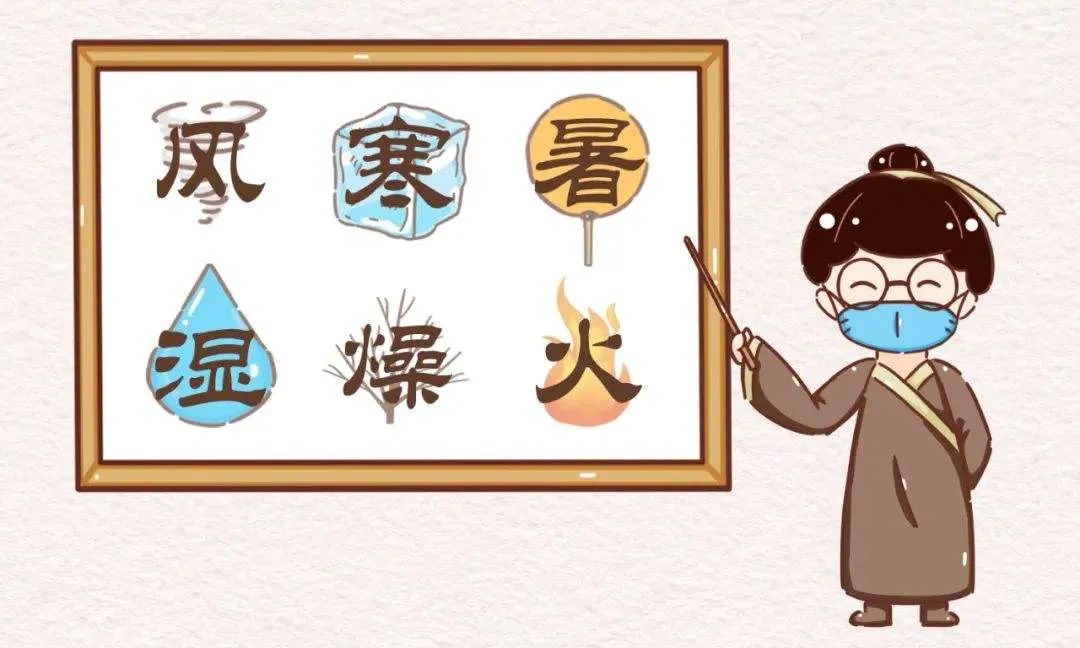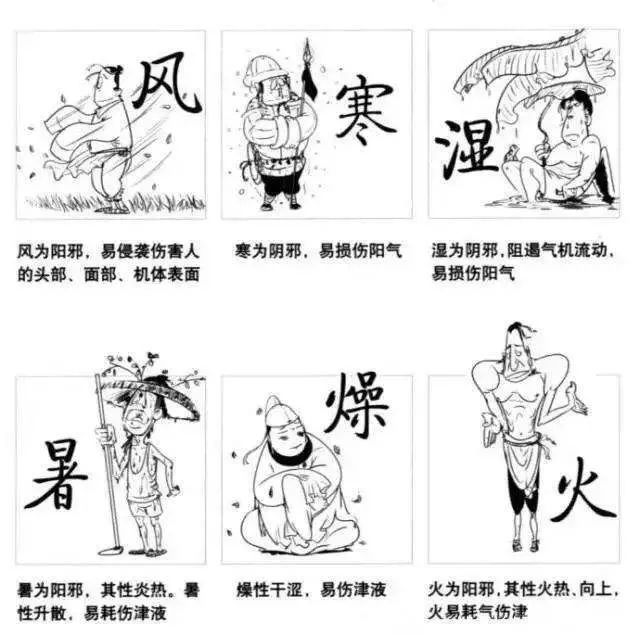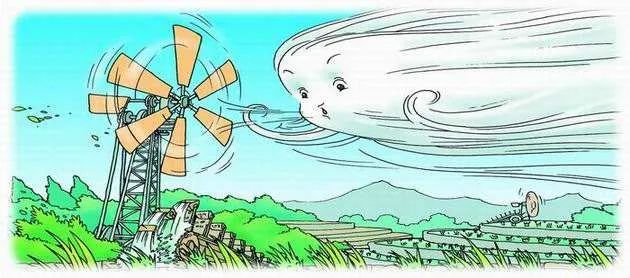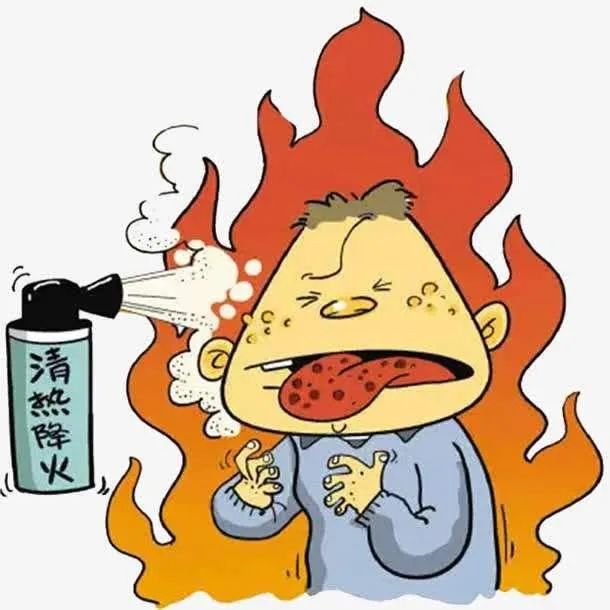The Six Evils refer to the six pathogenic factors: Wind, Cold, Heat, Dampness, Dryness, and Fire. The differentiation of the Six Evils is a method of analyzing and summarizing various clinical data collected through the four examinations (inspection, auscultation, inquiry, and palpation) to determine whether the current pathological essence of the disease is related to the Six Evils.

The occurrence of diseases related to the Six Evils is often associated with seasonal climate and environmental conditions. For example, Wind diseases are more common in spring, Heat diseases in summer, Damp diseases in late summer, Dryness diseases in autumn, and Cold diseases in winter. Prolonged exposure to damp environments can lead to Damp diseases, while working in high-temperature conditions can often result in Dry Heat diseases.
Since the occurrence of diseases related to the Six Evils is due to the invasion of external pathogens, these diseases can exist independently, overlap with each other, or transform under certain conditions.

Below is a guide to differentiate the Six Evils, teaching you how to quickly identify diseases caused by these evils.
◆◆Wind Evil Syndrome◆◆

Wind Evil Syndrome refers to the invasion of Wind pathogens affecting the skin and meridians, leading to dysfunction of the defensive Qi (wei qi), presenting symptoms characteristic of Wind.
This syndrome is caused by sudden climate changes, environmental discomfort, or physical weakness leading to the invasion of Wind. Wind is a Yang pathogen, characterized by its ability to disperse and invade Yang positions, often accompanied by other pathogenic factors. Therefore, Wind Evil Syndrome is characterized by rapid onset, quick changes, and erratic symptoms. Different locations of the disease can lead to different clinical manifestations.
Clinical manifestations include aversion to Wind and Cold, slight fever, sweating, floating and relaxed pulse, thin white tongue coating; nasal congestion, clear nasal discharge, sneezing; or sore throat, cough; or sudden skin itching, rashes; or sudden numbness of the skin, facial drooping; or wandering joint pain; or sudden facial and limb swelling.
◆◆Cold Evil Syndrome◆◆

Cold Evil Syndrome refers to the invasion of Cold pathogens, which restrain Yang Qi, primarily manifesting as aversion to Cold, absence of sweating, localized cold pain, and a tight pulse.
This syndrome is often caused by exposure to rain, cold water, wearing insufficient clothing, sleeping outdoors, staying in extremely cold environments, or consuming raw and cold foods. Cold is a Yin pathogen, characterized by its ability to stagnate, constrict, and easily harm Yang Qi.
Clinical manifestations include severe aversion to Cold, possible fever, absence of sweating, body aches, nasal congestion or clear nasal discharge, floating and tight pulse; or cough, asthma, and expectoration of thin white phlegm; or abdominal pain, diarrhea, vomiting; or cold limbs, localized stiffness and cold pain. Patients may experience no thirst, long clear urine, pale or bluish complexion, white tongue coating, and a wiry or hidden pulse.
◆◆Heat Evil Syndrome◆◆

Heat Evil Syndrome refers to the invasion of Heat pathogens, which consume Qi and injure body fluids, primarily manifesting as fever, sweating, thirst, and fatigue.
This syndrome is caused by exposure to external Heat during the hot summer months. The pathogenic nature of Heat is strictly seasonal. Heat is a Yang pathogen, characterized by its ability to disperse heat, consume Qi, and easily combine with Dampness.
Clinical manifestations include fever with aversion to heat, sweating, thirst with a preference for drinking, shortness of breath, fatigue, heaviness in limbs, short yellow urine, red tongue, white or yellow tongue coating, and a weak rapid pulse; or sudden fainting, continuous sweating, shortness of breath, and even coma, convulsions, or seizures; or high fever, confusion, chest tightness, abdominal pain, nausea, and absence of sweating.
◆◆Damp Evil Syndrome◆◆

Damp Evil Syndrome refers to the invasion of external Dampness, which obstructs the body’s Qi and clear Yang, primarily manifesting as heaviness in the head and body, fatigue, and joint pain.
This syndrome is often caused by humid weather, exposure to rain, or mist. Damp Evil Syndrome is also known as External Dampness Syndrome. Dampness is a Yin pathogen, characterized by its ability to obstruct Qi, harm Yang, and create a sticky, heavy condition.
Clinical manifestations include a heavy head, drowsiness, body heaviness, chest tightness, poor appetite, nausea, joint and muscle pain, loose stools, and cloudy urine. There may also be localized leakage of damp fluids or skin rashes, and women may experience increased vaginal discharge. The complexion may appear dull, with a slippery tongue coating and a soft or weak pulse.
◆◆Dry Evil Syndrome◆◆

Dry Evil Syndrome refers to the invasion of Dryness, which depletes body fluids, primarily manifesting as dryness of the mouth, nose, throat, and skin.
This syndrome is often caused by dry autumn weather or living in arid environments. The occurrence of Dry Evil Syndrome has clear seasonal or regional characteristics. Dryness is characterized by its ability to dry out, consume fluids, and easily harm the lungs.
Clinical manifestations include dry skin, cracked lips, dry mouth and throat, thirst, dry tongue coating, dry stools, or dry cough with little phlegm, short yellow urine, and a floating pulse.
In addition to the above clinical manifestations, cool dryness often presents with aversion to Cold and fever, absence of sweating, headache, and a floating or relaxed pulse; warm dryness often presents with fever and sweating, sore throat, irritability, red tongue, and a rapid pulse.
◆◆Fire Evil Syndrome◆◆

Fire Evil Syndrome refers to the invasion of Warm Heat Fire pathogens, which lead to internal excess of Yang Heat, primarily manifesting as fever, thirst, flushed face, constipation, yellow urine, red tongue, yellow tongue coating, and a rapid pulse.
This syndrome is often caused by the invasion of Warm Heat Fire pathogens or the accumulation of other external pathogens that transform into Heat. Fire, Heat, and Warm pathogens belong to the same category, differing only in intensity. Warm is a gradual increase of Heat, while Fire is the extreme of Heat, hence they are often referred to together. Fire, Heat, and Warm pathogens are Yang pathogens, characterized by their ability to scorch, consume fluids, and easily cause sores and ulcers.
Clinical manifestations include fever with aversion to heat, irritability, thirst with a preference for drinking, profuse sweating, constipation, short yellow urine, flushed complexion, red or crimson tongue, dry or yellow tongue coating, and a rapid and forceful pulse (such as flooding, rapid, or wiry). In severe cases, symptoms may include confusion, delirium, convulsions, vomiting blood, or bleeding.
 END
END
Scan the QR code below to learn for free (required for certification and expertise)
Shang Han Lun, Wen Bing Xue, Jin Gui Yao Lue, Huang Di Nei Jing, Shen Nong Ben Cao Jing, Yi Jing, Basic Theory of TCM, TCM Diagnosis, Chinese Materia Medica, Formulas, Acupuncture and Tuina, TCM Internal Medicine, TCM Gynecology, TCM Pediatrics, Meridian and Acupuncture Points, Anatomy, etc.


